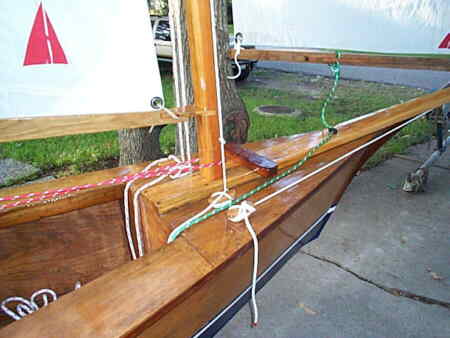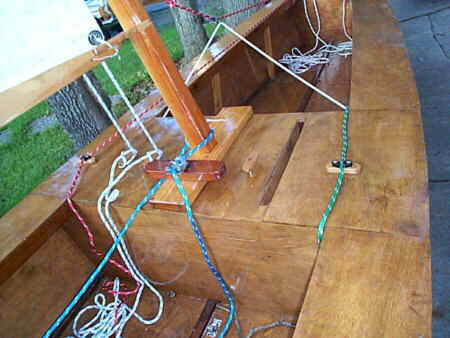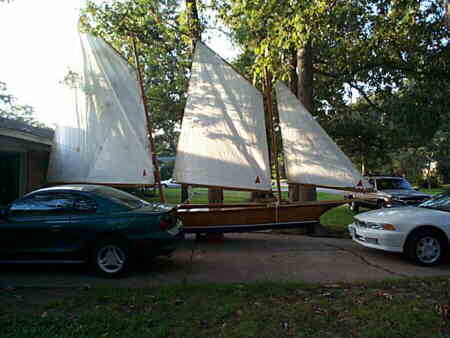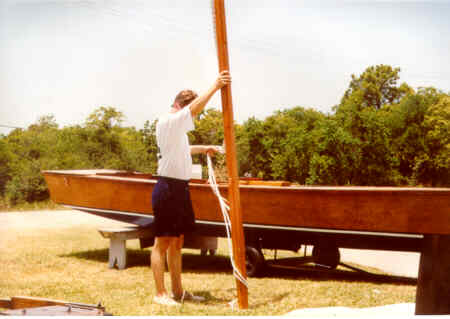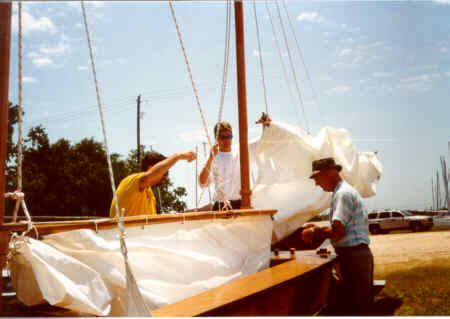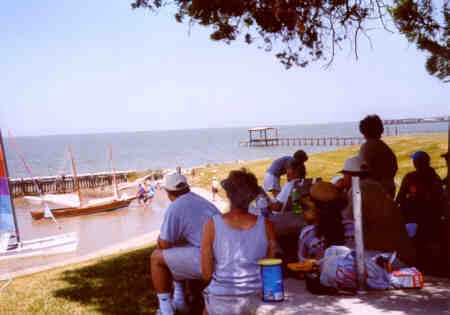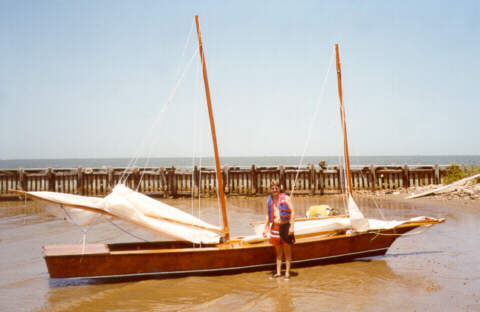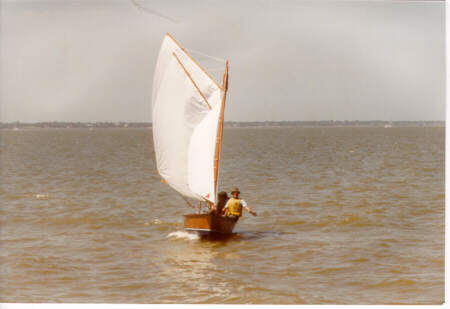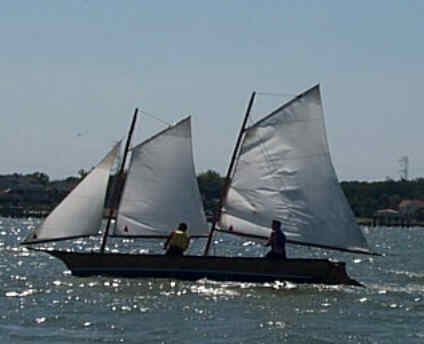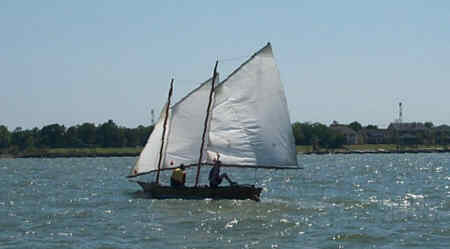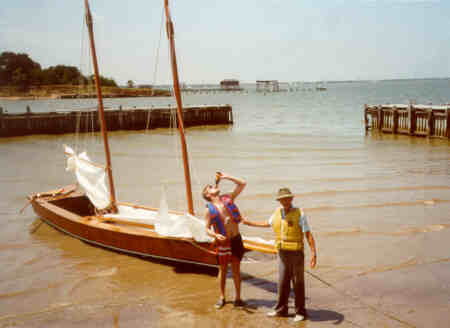|
Light
Schooner Building |
|
|
Here's the rest of Stephen Devine's Light Schooner building diary and photos. For the first half of the construction, see the first instalment. We remind readers, including those terrified at the thought of sailing once construction is complete, that THIS IS HIS FIRST BOAT! We've included some of the email interchanges regarding sail set and initial problems as a help to those who also may be intent on capsizing at the earliest possible stage!! Read on...] |
|
|
|
|
|
|
|
|
|
|
|
Stephen writes: "Since the last time I wrote, I finished my boat, named her, had a prelaunch party, a launching, and sailed her with a couple of adventures! The boat is named 'Faith' because if you have a little faith you can accomplish anything! And a little faith will carry you a long way...but...you gotta have faith to sail her!!!! "I finished construction in early July, and launched on July 15, 2000. Prelaunch was at my house the night before, and many friends came. The launching was great, and a passing trimaran took the action pictures. We tried to catch it but of course, we didn't. " |
|
|
|
|
|
|
|
|
|
Stephen: 'She does look good doesn't she? FUN to sail, but she won't think twice about dumping you. A little boy said she was a sexy boat. And it couldn't be more true. Responds quickly to anything, fast, slender, agressive. Always wants to GO. The number one comment... "Not very beamy, is she?" ' |
|
[Now for the Dorothy Dix questions: have a look at these early sailing tryouts and read Stephen's emails and the Flying Tadpole responses:] |
|
|
SD: Hey, we are finding it difficult to keep Faith upright, but I am going out with only one crew member. My suspicion is that we need at least 3-4 people to keep her up. Okay, truth time. we took her out 3 times and tipped her twice. Am I not carrying enough weight? We can't seem to dump enough wind out of the sails quick enough, and then the booms are in the water- by then it is too late. What has been your experience? Okay stop laughing now. Also, you talk about 20 and 30 mph winds- tell me more. I can't imagine sailing at all in that. Now up until the time that we actually go over, we are ripping across the water and having a grand time passing most boats. What do you think about trapezes? |
|
|
At the moment, the jib and the foresail appear more-or-less OK. The main has been hoist too high to begin with. Two major consequences, first you can't peak it up properly as the gaff is too high, second the sail has a lot more leverage with the extra 10-12" up the mast. Try to set where we have ours, with the boom jaws at no more than 8 inches above the deck. Main topping lifts (the single line doubled about the mast that holds the boom up and acts as a lazyjack too). Have these set up initially for hoisting but LET THEM OFF once you've hoisted. They really, really need to be very slack with a pronounced curve. Check out photos of well-set sails and look at the slackness of the topping lifts. |
|
|
So far, we've corrected responses to gusts (turn AWAY from wind), reduced sail leverage and improved set (let your topping lifts be slack once hoisted). Now,
=oversheeting=. This is a hard one, needing practice and depending on
the cut of your sails. Only rule I can give is that sails should always be
out a bit further than you'd think. The jib the most (bends airflow
onto the...)foresail a bit less out (bends airflow onto the...) mainsail out
least of all BUT mainsheet handler/helmsman ready to release to avoid knockdown. Check our how to sail notes carefully: you need to cleat
the main but cleat it with a lot of slack in the sheet so you've got time to
let it go... |
|
Trapezes? I've thought about that too! Your seated position in the photo looks fine, though. Oversheeting is causing you unnecessary problems, but you have to ride out on the rail with a crew of two. Don't try for the absolute maximum pointing: free your sheets up, fall off a bit and go just that bit faster. BTW your winds are at the point where I'd be thinking about reefing if I weren't racing. Finally...In an impending knockdown, DO NOT TURN UP INTO THE WIND. Turn AWAY, repeat AWAY from the wind. Luffing up results in the ruder acting like a dive elevator, and it will finish the sink-the-rail-under-the-surface trick. In contrast, bearing away picks up the speed while allowing the boat to come upright, and with the additional speed you can come back onto the wind safely. Leave "witching" until you're more familiar. NB in this respect a LS is like a catamaran, which always bears away in a gust |
|
'The cats still pass us and leave us though. How do you beat a cat?' FT2: sneak up on it in the parking lot and clobber it with your mainmast.... |
|
|
|
Stephen Devine's final note to new builders: 'You will practice sailing other boats, and read stories like Gregg Carlson's and say to yourself 'I'm not going to tip'. You build your boat, and get out there and the first thing you notice is that wow, its fast! You start tearing up the water, and you might even get back in without incident. 'This is only lulling you into trickery thinking you know how to do this. That is a worse situation, as you are drunk with the knowledge of what the schooner will do. Then, you go out and in front of people make an idiot out of yourself. 'Rest
assured, the light schooner MUST baptize you, like it or not. So, you might
as well get it in your head that you like it. ' |
| Building Tips | Light Schooner Homepage |

